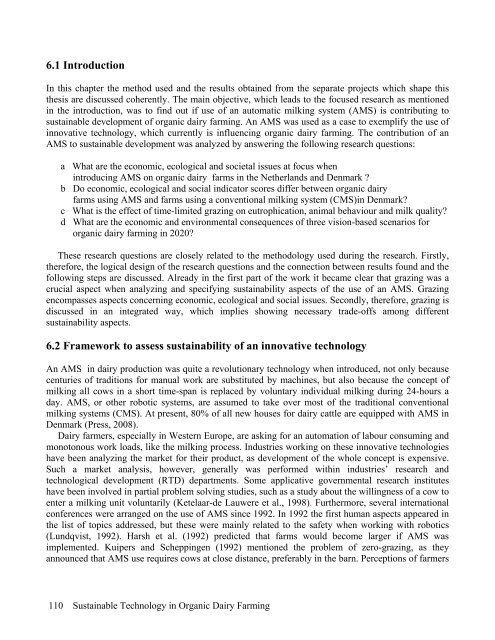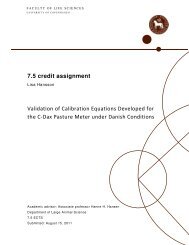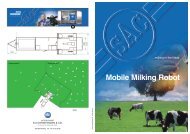Innovative Technology and Sustainable Development of Organic - 1.
Innovative Technology and Sustainable Development of Organic - 1.
Innovative Technology and Sustainable Development of Organic - 1.
You also want an ePaper? Increase the reach of your titles
YUMPU automatically turns print PDFs into web optimized ePapers that Google loves.
6.1 Introduction<br />
In this chapter the method used <strong>and</strong> the results obtained from the separate projects which shape this<br />
thesis are discussed coherently. The main objective, which leads to the focused research as mentioned<br />
in the introduction, was to find out if use <strong>of</strong> an automatic milking system (AMS) is contributing to<br />
sustainable development <strong>of</strong> organic dairy farming. An AMS was used as a case to exemplify the use <strong>of</strong><br />
innovative technology, which currently is influencing organic dairy farming. The contribution <strong>of</strong> an<br />
AMS to sustainable development was analyzed by answering the following research questions:<br />
a What are the economic, ecological <strong>and</strong> societal issues at focus when<br />
introducing AMS on organic dairy farms in the Netherl<strong>and</strong>s <strong>and</strong> Denmark ?<br />
b Do economic, ecological <strong>and</strong> social indicator scores differ between organic dairy<br />
farms using AMS <strong>and</strong> farms using a conventional milking system (CMS)in Denmark?<br />
c What is the effect <strong>of</strong> time-limited grazing on eutrophication, animal behaviour <strong>and</strong> milk quality?<br />
d What are the economic <strong>and</strong> environmental consequences <strong>of</strong> three vision-based scenarios for<br />
organic dairy farming in 2020?<br />
These research questions are closely related to the methodology used during the research. Firstly,<br />
therefore, the logical design <strong>of</strong> the research questions <strong>and</strong> the connection between results found <strong>and</strong> the<br />
following steps are discussed. Already in the first part <strong>of</strong> the work it became clear that grazing was a<br />
crucial aspect when analyzing <strong>and</strong> specifying sustainability aspects <strong>of</strong> the use <strong>of</strong> an AMS. Grazing<br />
encompasses aspects concerning economic, ecological <strong>and</strong> social issues. Secondly, therefore, grazing is<br />
discussed in an integrated way, which implies showing necessary trade-<strong>of</strong>fs among different<br />
sustainability aspects.<br />
6.2 Framework to assess sustainability <strong>of</strong> an innovative technology<br />
An AMS in dairy production was quite a revolutionary technology when introduced, not only because<br />
centuries <strong>of</strong> traditions for manual work are substituted by machines, but also because the concept <strong>of</strong><br />
milking all cows in a short time-span is replaced by voluntary individual milking during 24-hours a<br />
day. AMS, or other robotic systems, are assumed to take over most <strong>of</strong> the traditional conventional<br />
milking systems (CMS). At present, 80% <strong>of</strong> all new houses for dairy cattle are equipped with AMS in<br />
Denmark (Press, 2008).<br />
Dairy farmers, especially in Western Europe, are asking for an automation <strong>of</strong> labour consuming <strong>and</strong><br />
monotonous work loads, like the milking process. Industries working on these innovative technologies<br />
have been analyzing the market for their product, as development <strong>of</strong> the whole concept is expensive.<br />
Such a market analysis, however, generally was performed within industries’ research <strong>and</strong><br />
technological development (RTD) departments. Some applicative governmental research institutes<br />
have been involved in partial problem solving studies, such as a study about the willingness <strong>of</strong> a cow to<br />
enter a milking unit voluntarily (Ketelaar-de Lauwere et al., 1998). Furthermore, several international<br />
conferences were arranged on the use <strong>of</strong> AMS since 1992. In 1992 the first human aspects appeared in<br />
the list <strong>of</strong> topics addressed, but these were mainly related to the safety when working with robotics<br />
(Lundqvist, 1992). Harsh et al. (1992) predicted that farms would become larger if AMS was<br />
implemented. Kuipers <strong>and</strong> Scheppingen (1992) mentioned the problem <strong>of</strong> zero-grazing, as they<br />
announced that AMS use requires cows at close distance, preferably in the barn. Perceptions <strong>of</strong> farmers<br />
110 <strong>Sustainable</strong> <strong>Technology</strong> in <strong>Organic</strong> Dairy Farming




